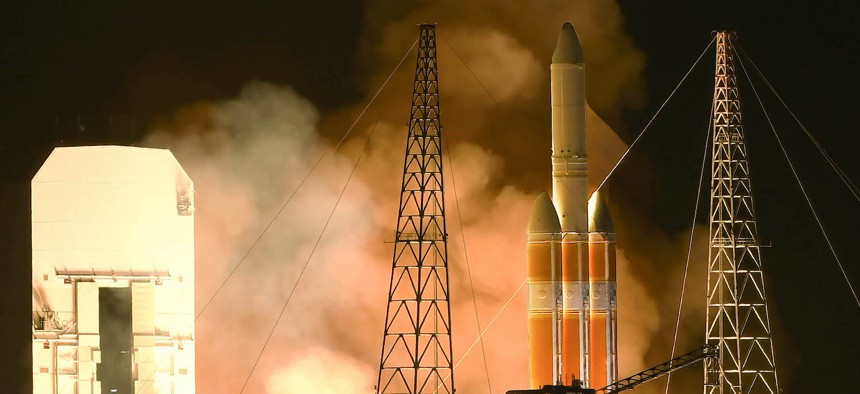
In this 2023 photo, a United Launch Alliance Delta IV Heavy rocket lifts off from Cape Canaveral Space Force Station carrying a classified spy satellite for the National Reconnaissance Office. Paul Hennessy / SOPA Images / LightRocket via Getty Images
Spy agency ready to launch new vehicle-tracking satellites
After tests go well, NRO director looks to start replacing JSTARS aircraft with orbital sensors.
The National Reconnaissance Office is gearing up to launch new satellites that will enable the U.S. military and intelligence community to track moving vehicles and people from space.
The Air Force wants to replace its aging E-8 JSTARS aircraft, which provide targeting data, with more survivable space assets and hand off a part of the ground moving target indicator mission, called GMTI, to satellites.
The NRO already put satellites into orbit to test out the concept—and now the agency is ready to launch satellites for operations, said Christopher Scolese, director of the NRO.
“The prototypes went up there. They were delivered in about 36 months from concept to launch, have operated fine, and we have exercised with Space Force and the other services, to prove their capability and that we’re able to move on to production,” Scolese said Wednesday at the National Security Innovation Base Summit, hosted by the Ronald Reagan Institute.
The NRO did not disclose when they would start launching the new satellites, or when the systems would be operational.
The agency is developing the program with the Space Force, whose operators will fly the new satellites and point the sensors.
While unclassified details about the program are sparse, the Space Force plans to work with the NRO to “develop and field GMTI system” in fiscal year 2025, according to budget documents.
The service is requesting $244 million in its 2025 budget for its “Long Range Kill Chains” program, which includes the GMTI effort and “auxiliary payloads,” and it plans to spend more than $1.2 billion over the next few years.
“Space-based GMTI system will provide actionable information on adversary surface targets to the warfighter through the Advanced Battle Management System (ABMS) as an integral part of Joint All-Domain Command and Control (JADC2) concept. The USSF is working with the Air Force and the intelligence community in a complementary way to design, develop, and deploy space-based GMTI systems,” according to documents.
However, Space Force officials have said that the GMTI program can’t move forward until Congress passes a fiscal 2024 budget because the effort is a new start in last year’s budget request.
